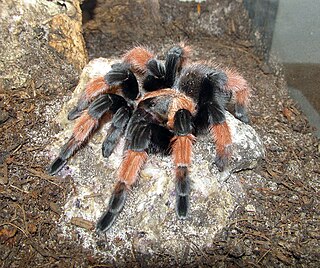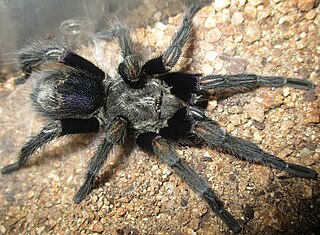
Avicularia is a genus of the family Theraphosidae containing various species of arboreal tarantulas. The genus is native to Panama, the Caribbean and tropical South America. Each species in the genus has very distinguishable pink foot pads.

Brachypelma is a genus of spiders in the family Theraphosidae (tarantulas). They may have bodies up to 6 cm long with legs of similar or greater lengths. Some species have brightly colored legs, with red or orange marks and rings.

Aphonopelma is a genus of tarantulas native to the Americas. It includes nearly all the North American tarantula species north of Mexico and a considerable percentage of the tarantula species that range into Central America. Most are fairly large tarantulas with leg spans of 6 in (16 cm) or more. Like most New World tarantulas, all species of Aphonopelma have urticating hairs. Despite their fearsome appearance, these tarantulas are not harmful to humans and some species are popular in the pet trade. With about 90 species described so far, Aphonopelma comprises about 10% of the total number of described tarantula species. However, their taxonomy is poorly understood and species are difficult to tell apart, especially those that are brown or black without other pattern. Therefore, the actual number of species is unknown, with more species likely to be identified in the near future. In captivity, they are usually fed crickets; in the wild, they eat most insects, including crickets, grasshoppers, cockroaches, mantises, and beetles.

Brachypelma smithi is a species of spider in the family Theraphosidae (tarantulas) native to Mexico. It has been confused with Brachypelma hamorii; both have been called Mexican redknee tarantulas. Mexican redknee tarantulas are a popular choice as pets among tarantula keepers. Many earlier sources referring to B. smithi either relate to B. hamorii or do not distinguish between the two species. B. smithi is a terrestrial tarantula native to Pacific coast of the Mexican state of Guerrero.

Chromatopelma is a monotypic genus of South American tarantulas containing the single species, Chromatopelma cyaneopubescens. Commonly known as greenbottle blue tarantulas due to their metallic blue legs and blue-green carapace, they are very active and fast-growing tarantulas that are particularly attractive to hobbyists. They are native to the Paraguaná Peninsula.

Tliltocatl vagans is a species of tarantula known commonly as the Mexican red rump. It ranges predominantly in Mexico, but is also found in Central America. They are terrestrial, burrowing spiders. The reason for the name red rump is because of its distinctive red hairs on its abdomen. Like most tarantulas, they will eat anything they can overpower, which is usually insects, but small lizards and rodents may also be consumed. They can grow up to a solid 6.5 inch leg span, with males typically being smaller and thinner than the females. They prefer shrubland habitats.

Brachypelma klaasi is a tarantula endemic to Mexico and it is the rarest of the genus Brachypelma.
Aphonopelma pallidum is a tarantula of the family Theraphosidae found in Mexico. Commonly called the rose-grey, or Mexican rose, it is not available in the pet-trade.

Euathlus is a genus of South American tarantulas that was first described by Anton Ausserer in 1875. These spiders are medium sized and are usually found in high elevations in the Andes. It is a senior synonym of Paraphysa, and was formerly considered a senior synonym of Brachypelma, but this was later rejected.

Brachypelma boehmei is a tarantula native to Mexico in Guerrero state. These long-lived tarantulas prefer burrowing and hiding in dry scrubland. As with all closely related tarantula species, they defend themselves with urticating hair when provoked.

Tarantulas comprise a group of large and often hairy spiders of the family Theraphosidae. As of August 2022, 1,040 species have been identified, with 156 genera. The term "tarantula" is usually used to describe members of the family Theraphosidae, although many other members of the same infraorder (Mygalomorphae) are commonly referred to as "tarantulas" or "false tarantulas". Some of the more common species have become popular in the exotic pet trade. Many New World species kept as pets have setae known as urticating hairs that can cause irritation to the skin, and in extreme cases, cause damage to the eyes.

The Theraphosinae are a large subfamily of Mygalomorphae spiders in the family Theraphosidae found in the Neotropical realm.
Brachypelma baumgarteni is a tarantula endemic to Pacific coast of Michoacan, Mexico.

Sericopelma is a genus of tarantula, found in Central America from Nicaragua to Panama. The limits of the genus and its distribution have long been confused; it is closely related to the genus Aphonopelma. Sericopelma species are among the largest found in Central America. They can be kept as pets, although at least one species has been described as "very aggressive".

Aphonopelma anitahoffmannae is a species of spider in the family Theraphosidae, found in Mexico.

Tliltocatl epicureanus is a species of spider in the family Theraphosidae (tarantulas), found in the Yucatán Peninsula of Mexico.
Sandinista lanceolatum is a species of spider in the family Theraphosidae (tarantulas), native to Nicaragua and Costa Rica.

Tliltocatl verdezi is a species of spiders in the family Theraphosidae (tarantulas), found in Mexico.

Tliltocatl is a genus of North American tarantulas that was split off from Brachypelma in 2020. They are also large burrowing tarantulas, but don't have the striking red leg markings of Brachypelma species. A female T. vagans can grow up to 50 mm (2.0 in) long and legs can get as long as 55 mm (2.2 in). They are found predominantly in Mexico, with some species native to Central America. The name is derived from two Nahuatl words, "tlil", meaning "black", and "tocatl", meaning "spider". Habitat destruction and collection for the pet trade has led to this and Brachypelma to be protected under International Convention on International Trade of Endangered Species rules, beginning with B. smithi.















